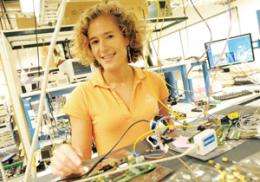Engineering professor works to speed up internet

Keren Bergman gets as aggravated as anyone by how long it takes to email a video of her son's recital to her parents. Unlike most people, Bergman, a professor of electrical engineering and department chair at the engineering school, can do something about it.
Bergman specializes in optical data, and her central research project involves the fiber optic network—the portion of the Web that consists of optical fibers over which data can be sent in the form of light waves. Fiber optics can handle large files—including the huge files of high-definition video—faster than traditional copper wires. Even so, the fiber optic network as it is currently configured isn’t very efficient.
“It’s like one big, dumb pipe,” Bergman says, adding that not much progress can be made if the pipe doesn’t smarten up. Internet traffic around the world reached 176 billion gigabytes in 2009, according to a report from the networking firm Cisco Systems Inc., an enormous amount of data for a network developed in the 1970s for a few thousand researchers.
Who could have dreamed that the social networking site Facebook would have 600 million users, many of whom, like Bergman, want to upload large video files of their children’s recitals? Or that the Internet might someday connect doctors at multiple locations via 3-D high-definition conference calls? Both uses require rapid delivery of large, high-quality audio and video files.
At its core the Internet has “waterfalls of bandwidth,” Bergman says, and should be able to handle the traffic. But traffic jams start as the volumes of information travel through narrower channels controlled by various Internet service providers. The current optical fibers can’t recognize what kind of data is coming through; when congestion hits, they are not able to prioritize traffic.
Bergman’s alternative model would insert a sort of smart switching system—think of trains coming into a station and being routed depending on where they’re going.
In her Lightwave Research Laboratory in Schapiro Hall, Bergman has set up circuit boards with fiber optic nodes designed to represent miniature slices of the Internet. The nodes are programmed to read data and direct it depending on what it is. In a perfect scenario, Bergman’s smart switching system could prioritize the hundreds of gigabytes carrying a medical video conference over the kilobytes of routine emails.
Bergman’s research has captured the attention of industry. Alcatel-Lucent Bell Labs and AT&T Research are collaborating with Bergman’s team on modeling these in their existing systems to see whether it could work on a larger scale. Bergman’s research team is a principal member of the Center for Integrated Access Networks, a consortium of nine colleges and universities, including Columbia, that’s based at the University of Arizona in Tucson and is working to solve the high-data transfer problem.
Bergman’s work has long straddled academia and industry. A graduate of Bucknell University, the Israeli-born Bergman received her Ph.D. in electrical engineering from MIT, after which she landed a teaching position at Princeton, where she still lives with her family. Before coming to Columbia in 2001, she was a consultant for Bell Laboratories and a lead technologist for the networking startup Tellium.
She hopes her research will also help relieve a problem that’s growing rapidly as computers gain capability: energy usage. “The energy consumption of information technology is growing exponentially,” she said.
Most of the energy—up to 90 percent—powers hardware (think of an overheated laptop) and copper wiring. Sending data down optical fibers, however, requires a fraction of the energy. Bergman says, “For the long haul in communications, it’s all fiber optics.”
Provided by Columbia University



















